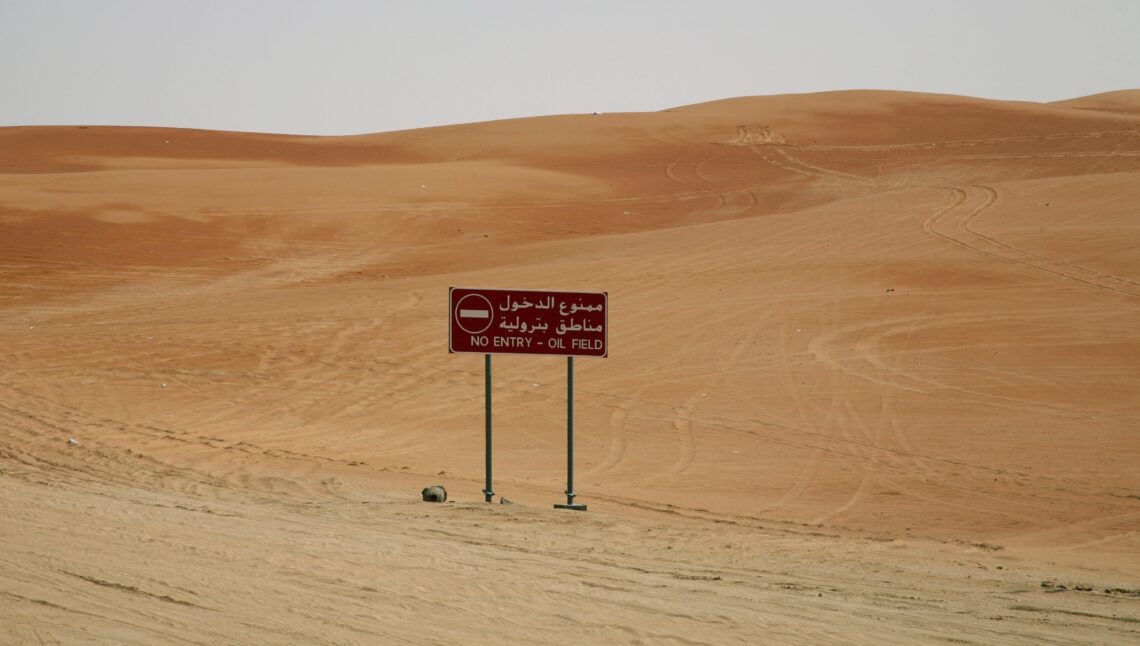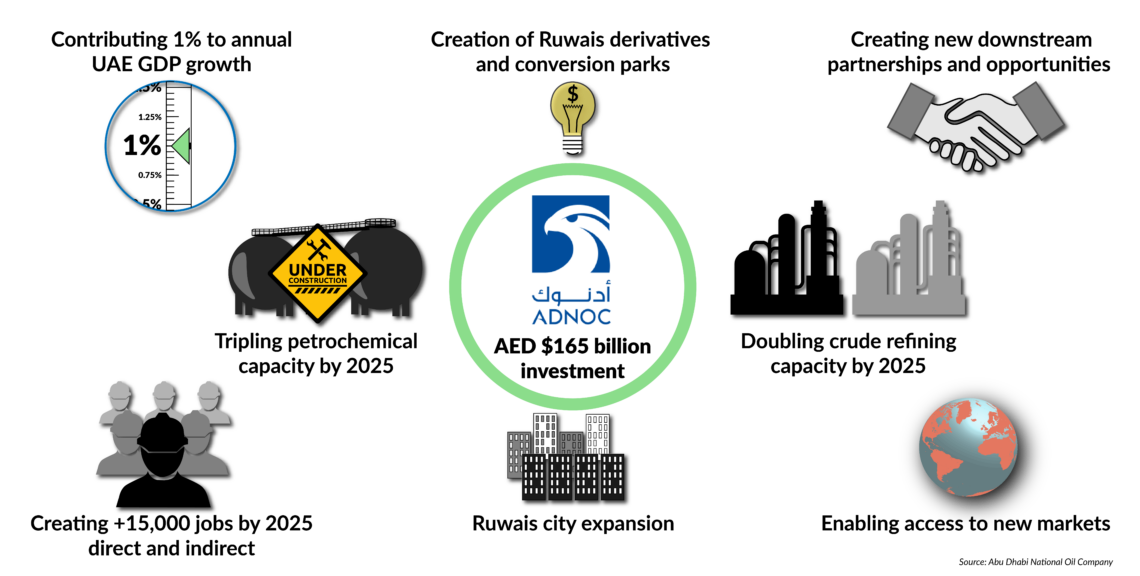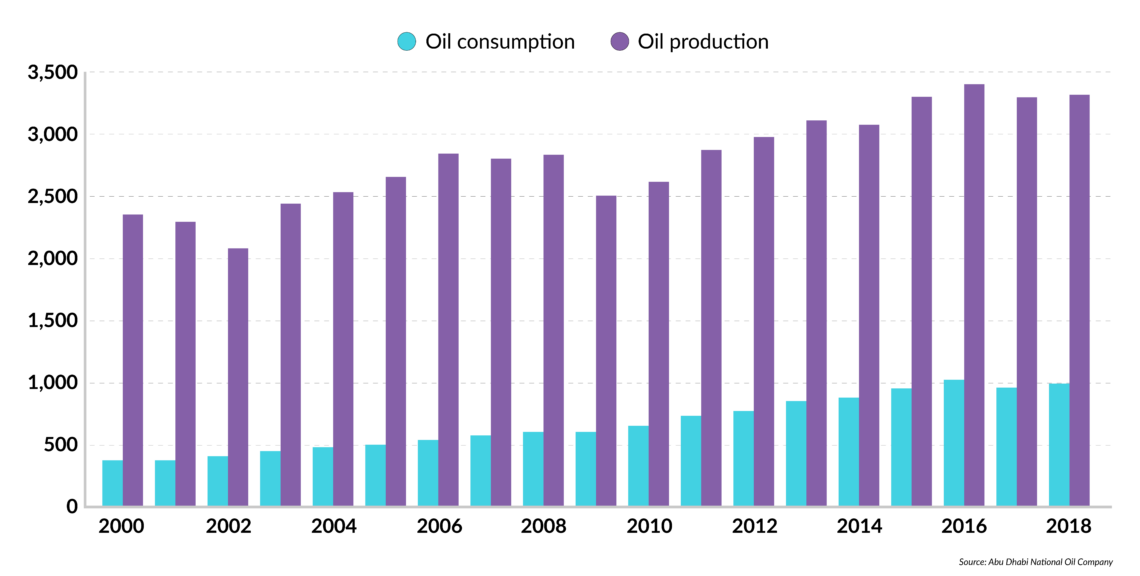The UAE’s oil and gas investment spree
The United Arab Emirates launched a five-year spending plan of more than $130 billion to improve its oil and gas production, ultimately aiming to become gas self-sufficient. The overhaul of the sectors could result in a larger share of the oil market, but only if environmental concerns do not cause a drop in demand.

In a nutshell
- The UAE could double its refining capacity and triple its petrochemical production by 2025
- This expansion could increase the country’s share of output in global oil markets and within OPEC
- The strategy will increase the UAE’s vulnerability to fluctuations in the oil market
In a world that is increasingly planning for the post-hydrocarbon age, the United Arab Emirates is heading in the opposite direction as it prepares for a battle of the fittest. If the highly competitive oil market starts to shrink, the low-cost producers will likely be the last to leave. The Emirates’ investment spree in the sector indicates it is not going anywhere anytime soon. Blessed with huge, low-cost oil reserves, the UAE is clearly at an advantage. However, size alone will not be enough.
Rapid expansion
In November 2018, the Supreme Petroleum Council, the Emirates’ highest governing body of oil and gas activities, approved a five-year spending plan of just over $130 billion by 2023 – roughly 30 percent of the country’s gross domestic product (GDP) – for the national oil company, the Abu Dhabi National Oil Company (ADNOC).
The plan entails a significant increase in oil production capacity – a target of 4 million barrels per day (mb/d) by 2020 and 5 mb/d by 2030. In 2018, the UAE produced 3.3 mb/d. The strategy also includes a large expansion of its petrochemical and refining business with the aim of creating the world’s largest facility by 2025. A total of $45 billion has been allocated by ADNOC to the downstream business, including the expansion of its Ruwais refinery, the UAE’s biggest. The program aims at doubling the country’s refining capacity and tripling petrochemical production by 2025.
Facts & figures
The downstream investment plan of the Abu Dhabi National Oil Company

There are also ambitious plans for natural gas. Unlike the oil sector, the UAE has been a net importer of natural gas since 2008, but the country’s vision is to become gas self-sufficient by 2030. Part of that self-sufficiency will be achieved by using less gas for electricity thanks to the Barakah nuclear power plant, and by developing new gas resources. In the longer term, the UAE hopes to become a net gas exporter.
Facts & figures
Oil in the emirates
- In 1971, the six emirates of Abu Dhabi, Ajman, Fujairah, Dubai, Sharjah, and Umm al-Quwain formed the federation of the UAE. One year later, they were joined by a seventh emirate, Ras al-Khaimah
- Oil was first discovered in what is now the UAE in 1958, before the country was founded.
- The UAE enjoys the fourth-lowest cost of production in the world at $12.30/bl, after Iraq ($10.50), Kuwait ($8.50) and Saudi Arabia ($9.90) (Rystad Energy)
- About 95% of the country’s potable water comes from plants built in the 1970s and 1980s
- The UAE joined OPEC in 1967, seven years after the organization was founded, and it has been an important member since
- The Dolphin pipeline has been transporting gas since 2007, under a 25-year contract, from Qatar’s North Field to Abu Dhabi’s Taweelah electricity and water desalination plants, then runs on to the northern emirates before ending in Oman
No shortage
With 97.8 billion barrels, the UAE sits on the world’s eighth-largest proven oil reserves (after Venezuela, Saudi Arabia, Canada, Iraq, Iran, Kuwait and Russia) or 6 percent of the world’s total. The majority of these reserves (94 percent) are located in its biggest and wealthiest emirate, Abu Dhabi, which accounts for more than three quarters of the country’s area.
Today the UAE is the seventh-largest producer in the world (after the United States, Saudi Arabia, Russia, Iran, Iraq and Canada), accounting for 4 percent of global output. Future production expansion plans are likely to come almost exclusively from Abu Dhabi’s existing mature oil fields through enhanced oil recovery (EOR), in line with recent trends, as exploration activity has not yielded any significant discoveries.
Although the country’s own oil consumption has been increasing in recent years, it still accounts for only around a quarter of domestic production, leaving a significant proportion for exports. Asia is the primary destination, absorbing 98 percent of the UAE’s oil exports.
Facts & figures
UAE Oil production and consumption

The UAE also sits on 5.9 trillion cubic meters (tcm) of natural gas reserves – the eighth in the world after Russia, Iran, Qatar, Turkmenistan, the U.S., Saudi Arabia and Venezuela. Most of the UAE’s natural gas production is associated gas or sour gas in nonassociated fields. Production from the associated gas fields is affected by oil production policy, which in turn depends on the UAE’s commitment to production quotas as an active member of the Organization of the Petroleum Exporting Countries (OPEC).
Furthermore, the Emirates’ natural gas has a relatively high sulfur content that makes it highly toxic and corrosive, thus technically challenging and expensive to process. As a result, the country has, for decades, simply flared (burned on the field) the associated gas.
Asia absorbs 98 percent of the United Arab Emirates’ oil exports.
At 57 percent of total consumption, natural gas is the UAE’s main source of energy. The country uses a large amount of natural gas in its extensive EOR operations and to operate its power and energy-intensive desalination plants. Gas imports via pipeline from Qatar (through the Dolphin project) and LNG cargoes have filled the gap between domestic production and consumption since 2008. Achieving gas self-sufficiency has become an even more important goal following the diplomatic rift with Qatar.
Drivers
The UAE’s oil production expansion will not only reinforce and potentially increase the Emirates’ share of output in global oil markets but also within OPEC, at the expense of other lagging producers. In 2018, the UAE’s crude oil production exceeded Iran’s for the first time in three decades. Between 2011 and 2015, when international sanctions targeted Iran’s energy sector, the UAE’s market share within OPEC increased from 8 percent to 10 percent. That share fell to 9 percent when Iran returned to the markets in 2017 but increased again to 10 percent in early 2019 as Iran suffered from the impact of U.S. sanctions reinstated in 2018.
Along with Saudi Arabia and Kuwait, the UAE is one of the only OPEC countries with significant spare capacity, estimated at 0.5 mb/d. Although dwarfed by that of Saudi Arabia’s, this capacity gives the UAE the strategic role of a “swing producer” because it can add or withdraw volumes from the global market quickly to help balance global supply and demand. This feature gives the country the additional advantage of flexibility over other producers, and production expansion will further enhance it.
The UAE has been trying to distinguish itself by building large storage facilities for oil and oil products.
The UAE has also been trying to distinguish itself from other producers by developing its status as a major trading hub by means of building large storage facilities for oil and oil products. The UAE’s main bunkering port in the Emirate of Fujairah is the world’s second largest after Singapore. In 2018, the UAE and South Korea agreed to build the world’s largest underground crude oil storage facility, also in Fujairah, to be completed in 2022. Located on the Indian Ocean, it will allow the UAE to bypass the Strait of Hormuz and therefore be less vulnerable to potential disruptions in the tight waterway.
ADNOC’s strategic storage projects are not limited to the UAE, though. The company signed an agreement with the Indian Strategic Petroleum Reserves Limited to store its crude oil at an underground facility in the Indian state of Karnataka. Such an investment will allow the UAE to be closer to its core customers in growing Asia.
Achilles’ heel
The UAE’s bold expansion plans are not without risks. The country’s Achilles’ heel is the fact that its economy remains dependent on hydrocarbon revenues, which make up nearly 70 percent of total revenues despite efforts to diversify the economy. While officials have been vocal about the growth of non-oil GDP, the latter still remains at the mercy of oil, moving in tandem with prices.
In this virtually single-commodity economy, vulnerability to external shocks is particularly high. In a competitive market with low prices, losses in petroleum export revenues will translate into shrinking fiscal revenues, because oil export earnings are captured almost entirely by the government, which results in large budget deficits.
The UAE considers the expansion of refining and petrochemicals as an important step away from oil. The International Energy Agency (IEA) also argues that such a strategy will allow the country to capture more value from hydrocarbons and promote economic diversification.
The UAE’s current social contract requires higher oil prices than the market would provide on its own.
“Downstream earnings typically move in a different direction from upstream earnings – they tend to be higher when crude oil prices are low, and vice versa – so they also provide a hedge against lower oil prices,” argues the IEA. However, the UAE will continue to be exposed to developments in global oil markets. If the “war on plastic” intensifies amid the fight against climate change, it could significantly dent demand for petrochemical products.
In other words, despite remaining a leading producer of crude oil, margins in refining and especially in the petrochemical industry may come under pressure – which would leave the UAE more exposed after the planned expansion in refining and petrochemical production has taken effect.
It seems that the UAE is trying to reinforce its position vis-a-vis its OPEC peers, which also have a heavy economic dependence on oil. Yet the UAE is mostly a single-commodity economy and its current social contract requires higher oil prices than the market would provide on its own. As long as that remains the case, the country’s ability to use low costs to crowd out other non-OPEC producers like the U.S. will be hampered by its big bets on oil and gas processing, irrespective of its ability to increase crude oil production.


